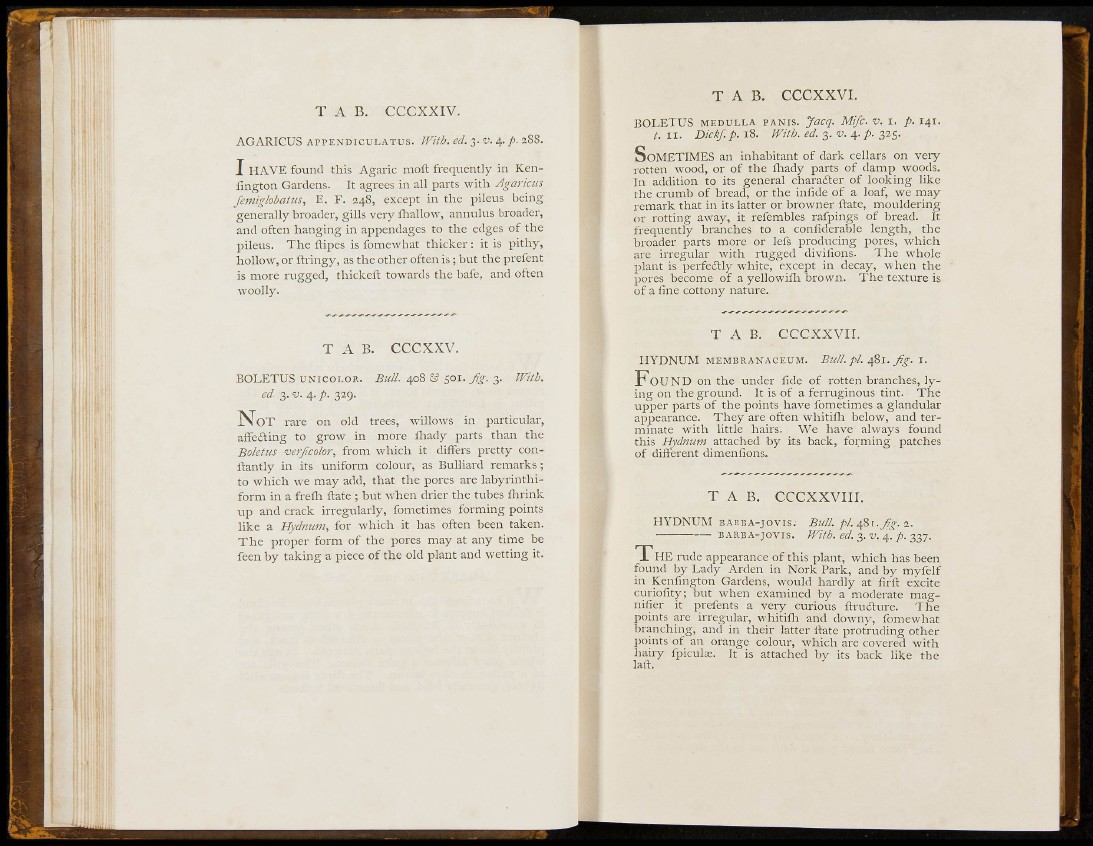
T A B . CCCXXIV.
AGARICUS APPENDICULATUS. With. ed. 3. v. 4. p. 288.
I HAVE found this Agaric moft frequently in Kenfington
Gardens. It agrees in all parts with Jgaricus
femiglobatus, E. F. 248, except in the pileus being
generally broader, gills very fliallow, annulus broader,
and often hanging in appendages to the edges of the
pileus. The ftipes is fomewhat thicker: it is pithy,
hollow, or ftringy, as the other often is ; but the prefent
is more rugged, thickeft towards the bafe, and often
woolly.
T A B. CCCXXV.
BOLETUS UNICOLOR. Bull. 408 S" 501. Jig. 3. With,
ed. 3. V. 4. p. 329.
N o t rare on old trees, willows in particular,
affeaing to grow in more iliady parts than the
Boletus mrjicolor, from which it differs pretty conftantly
in its uniform colour, as Bulliard remarks ;
to which we may add, that the pores are labyrinthiform
in a freili ftate ; but when drier the tubes ilirink
up and crack irregularly, fometimes forming points
like a Hydmmi, for which it has often been taken.
The proper form of the pores may at any time be
feen by taking a piece of the old plant and wetting it.
T A B . CCCXXVI.
BOLETUS MEDULLA PANIS. Jacq. Mifc. v. i, p. 141.
t. i-i. Dickf. p. 18. With. ed. 3. u. 4. p. 325.
SOMETIMES an inhabitant of dark cellars on very
rotten wood, or of the iliady parts of damp woods.
In addition to its general charailer of looking like
the crumb of bread, or the infide of a loaf, we may
remark that in its latter or browner ftate, mouldering
or rotting away, it refembles rafpings of bread. It
frequently branches to a confiderable length, the
broader parts more or lefs producing pores, which
are irregular with rugged divifions. The whole
plant is perfeftly white, except in decay, when the
pores become of a yellowifli brown. The texture is
of a fine cottony nature.
T A B . cccxxvir.
HYDNUM MEMBRANACEUM. Bull. pi. jig. 1.
F o u n d on the under fide of rotten branches, lying
on the ground. It is of a ferruginous tint. The
upper parts of the points have fometimes a glandular
appearance. They are often whitifli below, and terminate
with little hairs. We have ahi'ays found
this Hydnuni attached by its back, forming patches
of different dimenfions.
T A B. CCCXXVIII.
HYDNUM BAEBA-jovis. Bull. pi. Jig.
BARBA-JOVIS. With. ed. 3. V. 4. p. 337.
T h e rude appearance of this plant, which has been
found by Lady Arden in Nork Park, and by myfelf
in Kenfington Gardens, would hardly at firft excite
curiofity; but when examined by a moderate magnifier
it prefents a very curious ftruaure. The
joints are irregular, whitifli and downy, fomewhat
branching, and in their latter ftate protruding other
joints of an orange colour, which are covered with
lairy fpicute. It is attached by its back like the
laft.